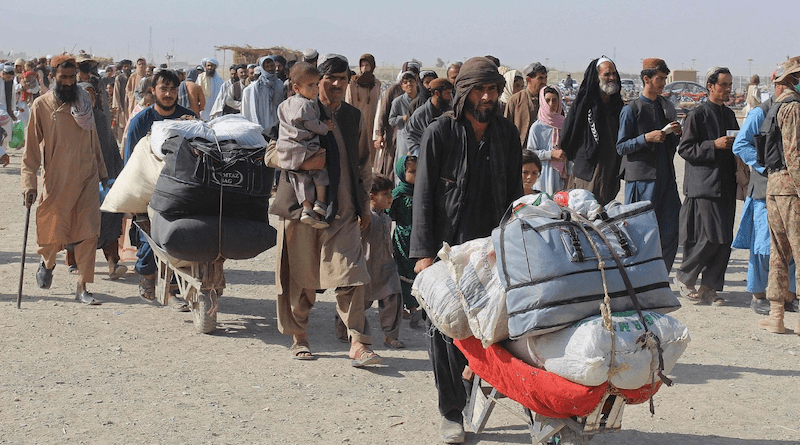Its Time For Afghan Refugees To Go Back – OpEd
By Asad Ali
Pakistan, the host of millions of Afghan refugees since the Soviet invasion, now seeks their expeditious repatriation. The process has already started and it is one of the largest repatriation programs in UNHCR’s history. However, around 3 million Afghans still reside in Pakistan. While repatriation is considered to be the most durable solution to refuges problems, and is being tried in the case of Afghans, comprehensive repatriation from Pakistan has not occurred. The changing nature of the Afghan conflict is gradually putting pressure on Pakistani policy-makers to look for alternative solutions.
Pakistan anticipates the return of over 3 million Afghan refugees because they pose an enormous economic burden. Pakistan maintained a policy of temporary protection with voluntary return as the preferred option; however, the goal of comprehensive repatriation remained elusive, hostage as it was to Pakistan’s official Afghan Policy and protracted fighting in Afghanistan. Even the end of the Cold War and withdrawal of the Soviet troops from Afghanistan in 1989 did not result in a successful return of all Afghan refugees, although the 1990s were hailed as the “decade of repatriation” throughout the world.
Repatriation occurs when a situation improves in the home country; unless the refugees themselves perceive an improvement in ground realities, they do not opt for return. Meanwhile, refugees’ presence has become a major concern and is gradually generating resentment in the local population. Many elements in Pakistan believe that Afghan refugees will never go back, even if the political situation in Afghanistan improves. This assumption, so far, holds true, notwithstanding the massive repatriations of 1992 and 2002. Afghans, on the other hand, say they do wish to return, but not at the risk of endangering their lives in a country where the same conditions that caused them to leave may arise again. Indeed, infighting in the country has resulted in new influxes of refugees.
The porous Pak-Afghan border has made it more difficult for Pakistan to check and prevent new refugees from entering, despite the change in its policy towards them. Afghanistan, Pakistan and UNHCR reached an agreement in principle on a legal framework governing the return of Afghan refugees, which established, for the first time, a formal process for resolving the issue. The agreement, which was signed in October 2002 and approved by the governments in March 2003, was designed to support a gradual organized return that was sustainable. Under the agreement, UNHCR would continue to assist the voluntary repatriation of Afghan refugees from Pakistan for three more years. After this period, Afghans remaining in Pakistan would undergo screening for the identification of those who might be in danger on their return and after assessing their situation they will be provided with security and protection.
The Afghan government has made the return and reintegration of returning refugees and internally displaced persons (IDPs) an important component of its National Development Framework. It recognizes that the reintegration process is both huge and complex, and the operational environment is extremely testing. UNHCR has therefore encouraged a practical division of labor, both strategically and sectorally, to meet this challenge. This approach is based on the premise that humanitarian assistance agencies have the capacity to respond rapidly to immediate, short-term needs and, at the same time, to lobby for the early engagement of other longer-term actors for the reintegration, rehabilitation, and reconstruction phases.
There had been no proper documentation of Afghans living in the country since their arrival in 1979. The available statistics could not provide a clear picture of the actual refugee population. In 2003-4, the Government of Pakistan worked out a plan to carry out a census to assess the numbers of Afghans in Pakistan. It would have been more useful if this process had been carried out at the beginning of the 2002 repatriation program; with the repatriation process underway, the survey was something of a delayed measure. However, it has importance for the future management of the Afghan population in the country.
The majority of reluctant Afghan refugees point to economic problems while 18 percent regard insecurity in Afghanistan as the main obstacle towards their return. Under international law, those staying for economic reasons are not entitled to asylum because the 1951 UN Convention Relating to Status of Refugee and its 1967 Protocol clearly exclude them from the definition of a refugee. In such circumstances, forced repatriation of refugees is likely to take place, despite the principle of non-refoulement (not to forcefully return refugees).
Pakistan is keen on repatriation and rehabilitation of all the refugees and has been urging the international community to create the necessary conditions and economic opportunities in Afghanistan as an incentive for people to return. Unless “pull factors” are strong and attractive, comprehensive repatriation is less likely to take place in the coming years. In an effort to resolve some of the shelter related problems, in 2005, the Afghan government began an ambitious land distribution to over 300,000 returnees. Some 13,000 plots of land were distributed, mostly in the provinces of Farah, Logar, Faryab and Parwan. In provinces where government land is not available for distribution, eligible returnees are to be provided land in a neighboring province that can absorb them. Kabul has said priority would be given to returnees who are disabled or widowed, and to families lacking a breadwinner. While this is a positive act on the part of the Afghan government, most of the returnees from Pakistan do not belong to the provinces mentioned.

